Maryville House
Houses within 10km of this house
Displaying 39 houses.
Houses within 10km of Maryville House
Displaying 39 houses.
| House name | Description | |
|---|---|---|
| Raheen | Raheen is associated with both the Kilkelly and O'Hara families. In the 1770s it seems to have been a residence of the Taylor family, with whom the O'Haras intermarried. In the 1830s the OS Name Books record it as "a neat house, in form like a cottage two stories high." Raheen House was badly damaged by fire in the latter part of the twentieth century. The entrance gateway is still extant. |

|
| Coole | Coole House was built in the late 18th century for Robert Gregory. It was demolished in 1941 but the gardens and some of the parkland are still extant and maintained by the Forestry and Wildlife Service. Part of the farm buildings now houses an interpretive centre and tea rooms. See www.coolepark.ie |

|
| Tullira | Lewis records Tillyra as the seat of J. Martyn. Tullira was originally a tower house which was modified at various times. The OS Name Books record it as a tower house with a modern house attached. The gardens included a hot house. In 1906 it was the property of Edward Martyn when the buildings were valued at £100. It is still extant and was the home of Lord and Lady Hemphill in the 20th century. It has had a number of owners since then and in 2013 was offered for sale. |

|
| Prospect (Kiltartan) | Occupied by A. Nolan in 1814. Lewis records Prospect as the seat of Nolan in 1837. By the time of Griffith's Valuation it appears to have been part of the estate of the representatives of Vicesimus Knox and leased to William Mulville. The house is still extant and occupied. |
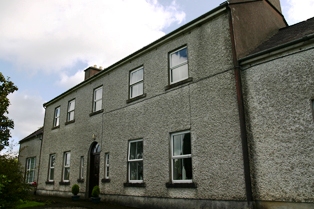
|
| Cloon | In 1814 Cloon House is recorded as the seat of B. Eyre. Lewis records the house as that of Burke Eyre in 1837. At the time of Griffith's Valuation Cloon House was occupied by Henry Lahiff when it was valued at £15. It is still extant and occupied by his descendents. |
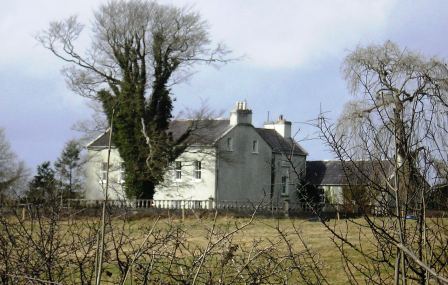
|
| Russaun (Russane) | Russaun, sometimes spelt Russane, appears to have become part of the Gregory estate, though occupied by the Bagot family, by the mid-19th century. At the time of Griffith's Valuation it was leased by William Gregory to John Bagot. However, in 1837 it was recorded by Lewis as the residence of the Lahiffe family. It is still extant and occupied. |

|
| Normangrove | In the 1850s the house at Normangrove, in the Kinvara area, was being leased by John O'Hara to Charles Higgins. In 1814 it had been recorded as the residence of John Burke and was also listed as a Burke house by Lewis in 1837. In 1906 Miss M.L. Forster held over 500 acres of untenanted land here as well as buildings valued at almost £3. The Forsters had held land at Normangrove at the time of Griffith's Valuation but no buildings. O'Connell states that the house was occupied until about 1914 and it fell into ruin therafter. The entrance and driveway lead to a farmyard and there is no trace of the house now. | |
| River View | River View was recorded as a seat of the Lopdell family by Lewis in 1837. By the time of Griffith's Valuation it was owned by the representatives of Vicisimus Knox and was being leased by the Vereker estate when it was valued at £5. It is now in ruins. | |
| Rosemeade/Lisheen | At the time of Griffith's Valuation this property was leased by Matthew Rosengrave to Patrick Carrick and valued at £21. It was accompanied by over 200 acres. In 1814 Lisheen was the seat of Jer. Rosingrave. The house is labelled on both the first and 25-inch editions of the Ordnance Survey map as Rosemeade but today is known as Lisheen. It is still extant and occupied as a farm house. |

|
| Castle Taylor/Ballymagrath | The house at Castle Taylor, originally known as Ballymacrath, was built adjacent to a tower house. The Taylor family had been settled there since the 17th century. In 1837 Lewis recorded it as the seat of Gen. Sir. J. Taylor. In 1894 and 1906 it was the residence of Walter Shawe Taylor and was valued at £50. It is now in ruins. |
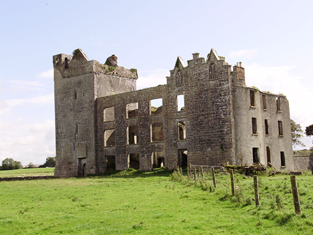
|
| Ballymantan/Ballynamantan | At the time of Griffith's Valuation Ballynamantan was leased by Edward J. Hunt to Francis J. Davys. It was then valued at £15. Lewis records the house as the seat of Lombard Hunt. An occupied house still exists at the site though it is not the original. |

|
| Doorus House | Dooras House was built by the French family in the 18th century. At the time of Griffith's Valuation Count de Basterot was leasing this property from Henry Comerford. In 1906 Count de Basterot was the owner of a mansion house valued at £10 here. O'Connell records that the house was demolished about 1917-18. | |
| Northampton | The townland of Poulnaveigh otherwise Northampton, containing Northampton House, "of modern construction", was offered for sale in the Encumbered estates court in June, 1865. In 1894 Slater refers to Northampton as the residence of Captain Harry de Vere Pery a son of the second Earl of Limerick. In 1906 it was the property of James Brady-Murray and was valued at £31. Northampton House is no longer extant having been demolished in the 1930s. http://www.northamptonns.com/index.php/eng/content/view/full/131 |

|
| Seapark House | This property is described as a caretaker's house on Christopher St. George's estate at the time of Griffith's Valuation when it was valued at £8. O'Connell states that it was locally known as "Foy's House" and was used as a fever hospital during the famine. It is now in ruins. |
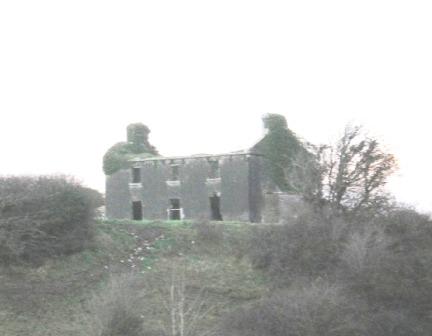
|
| Hermitage or Neptune | O'Connell states that this house was originally built by Dr. Nicholas Archdeacon, probably about 1805-6. It was later the property of the Blake family and in 1862 the house was known as Hermitage House and was the residence of Francis Blake Forster. It has been in ruins since the mid-20th century. |
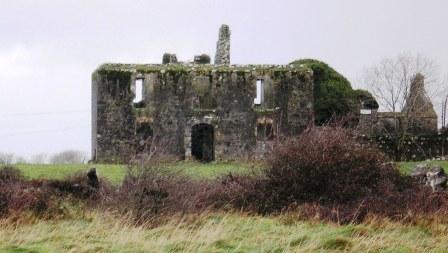
|
| Cregaclare | The Ordnance Survey Name Books mention that Cregaclare House was built in 1802. In the 1830s it is described as having elegant gardens and a Hot House producing various types of fruit. Cregaclare House is recorded by Lewis as the seat of J.S. Lambert in 1837. At the time of Griffith's Valuation it was leased by James Lambert to Lord Clanmorris and was valued at £50. Bought by Lord Clanmorris in the late 1850s, it was still his property in 1894 and 1906. Only the ruins of a basement and remains of stable yard and gateways are visible. Mausoleum located at M470118 in the ruins of old RC church. This was originally a burial place for the Bingham family (Lords Clanmorris) but those buried there were later re-interred in the grounds of the Church of Ireland, Ardrahan. |
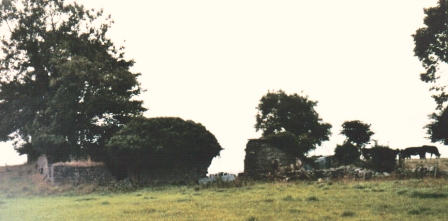
|
| Kilcolgan Castle | Christopher St. George, residing at Kilcolgan Castle, is described as a resident proprietor in county Galway in 1824. In the 1830s Kilcolgan Castle is described as the property of A.F. St. George. This house, part of the St.George estate, was leased by Matthew St.George from Christopher St.George, 1855. At that time Matthew St. George was acting as agent for the Rathbourne estate. Earlier, the Ordnance Survey Field Name books record that he was acting as agent for the estate of Patrick French in the nearby parish of Ballynacourty. In 1894 Slater refers to "Kilcolgan House" as the residence of James St. George. |

|
| Newtown Kilcolgan | Arthur St.George was leasing a house, valued at £8, at Newtown Kilcolgan, from Christopher St.George in 1855. Evidence of estate buildings still survive in this area though the house appears to be gone. | |
| Cloghballymore | Originally a tower house owned by the Kilkelly family, Cloghballymore House, was extended a number of times by the various families who held the estate over three centuries.. The National Inventory of Architectural Heritage indicates that the main house at the site was constructed by Marcus Lynch in the eighteenth century. In 1906 it was owned by Llewellyn Blake and was valued at £18. It was later given by him to a missionary order and maintained for some time as a seminary. The building is still extant and now used as St. Columba's nursing home. |
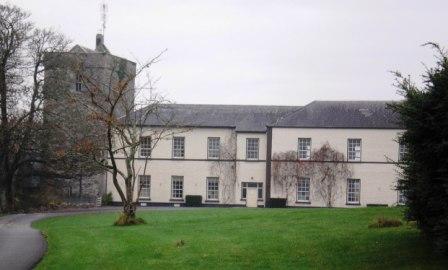
|
| Ballyclery | The house at Ballyclery is described as a caretaker's house for the St.George estate. It was valued at £8 in 1855. An occupied house still exists at this site but may have been modernised. | |
| Limepark | In 1855 the house at Limepark north, parish of Kilthomas, barony of Dunkellin, was in the possession of George Persse. Earlier in the 19th century the house was occupied by Thomas Wilton. This property was recorded as the seat of the Wallace family by Lewis in 1837. During the 1916 Rising it afforded shelter to the rebels from Galway. It is now a ruin. The farm of which it is a part was offered for sale in 2024. |
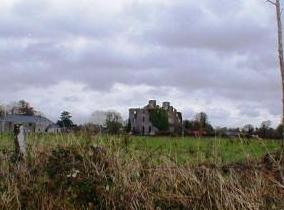
|
| Newpark | The Ordnance Survey Name books state that the townland was the property of John Nolan of Prospect, Gort in the 1830s. The house appears to have been built after that time. At the time of Griffith's Valuation, this property was leased by John Nolan to Andrew Nolan. In 1906 it was still the property of Andrew Nolan and was valued at £17. It is no longer extant. | |
| Castledaly | This property was in the possession of the Blake family from the late 16th century and was known as Corbally. In 1786 Wilson refers to the house as the seat of Mr. Blake. When Peter Daly acquired it in 1829 he had the castle remodelled and a facade added. The property then became known as Castledaly. Lewis records it as the seat of J. Daly in 1837. At the time of Griffith's Valuation it was the property of James Daly and the buildings were valued at £34. It was also the seat of James Daly in 1894. It is now a ruin. The mausoleum of the Daly family can be seen in the grounds of St. Theresa's church nearby, which they helped to build and where memorial tablets recording members of the family can be seen. |
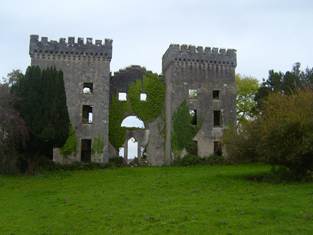
|
| Cappard | Lewis mentions Cappard as being the seat of the Mahon family in 1837. At the time of Griffith's Valuation it was occupied by James Galbraith and was valued at £40. by 1906 it was owned by Richard Galbraith and was valued at almost £54. Cappard House is no longer extant but the remains of an extensive stable block (M514067) are still visible. |

|
| Lavally (Kiltartan) | At the time of Griffith's Valuation, the representatives of Vicesimus Knox were leasing property valued at £47, including a mill,to John Langan, at Lavally, barony of Kiltartan. This building is no longer extant. | |
| Lisbrine House | At the time of Griffith's Valuation, Lisbrine was the residence of Richard Burke and was valued at £12. By 1906 it was owned by John Burke and was valued at £11 while a smaller house, valued at £6, was owned by Myles Burke. Lisbrine House is no longer extant. | |
| Roo | The original Roo House was a single story L-shaped building. Only a small portion, which has been incorporated into farm buildings, now remains. Tradition indicates that it was leased by Bishop Nicholas Archdeacon sometime in the early 19th century. In the 1830s it was the residence of a Mr. Sellers. The house and over 100 acres was leased by the Curtin family from the Gregory estate in the 1840s but the Gregorys were later obliged to sell this part of the estate. A two-story house, now derelict, was erected on the site in the early 20th century. The property is still held by the Curtin family. |

|
| Ballylee Castle | Lewis records the Carrig family as residennt at Ballylee Castle in 1837. At the time of Griffith's Valuation, Patrick Carrick was leasing a herd's house, old castle and land from William Gregory at Ballylee, barony of Kiltartan. The property was valued at £5 at the time. In the early century Ballylee Castle was bought and renovated by the poet, W.B. Yeats. After falling into disrepair again it was acquired by the Office of Public Works as a museum to the poet. It was severely damaged by flooding in 2009 and is not currently open to the public. |

|
| Rindifin Cottage | In 1786 Wilson refers to Rhyndifen as the seat of Prendergast Smyth. Lewis records Rhyndifin as the seat of the Blaquiere family in 1837. It was occupied by Mary Moloney at the time of Griffith's Valuaiton, leasing from the Knox estate and was valued at £4. The entrance gateway is extant and a house still occupies the original site. |

|
| Annagh Cottage (Kiltartan) | In 1786 Wilson refers to Annagh as the seat of Mr. Burke. Redmond Burke is recorded as residing at Annagh in 1814. The house at Annagh, barony of Kiltartan, was occupied by Redmond Burke at the time of Griffith's Valuation, when it was valued at £10. Redmond Burke of Annagh, sold property in the Land Judges' Court in 1882. Annagh Cottage does not appear on the 25-inch Ordnance Survey map of the 1890s and no trace remains of it now. | |
| Forthill Cottage | Lewis records a Burke family resident at Forthill in the parish of Kilbeacanty in 1837. By the time of Griffith's Valuation the holding was being leased by Michael Diviney from William Gregory. The house was valued at £2 but was vacant at that time. It is no longer extant. | |
| Seamount | Seamount House was built by the Butlers of Cregg in the 18th century. O'Connell notes that Seamount was the residence of Maj. Theobald Butler, who had fought at the Battle of Waterloo, during the 1820s. At the time of Griffith's Valuation Denis Hynes was leasing from Edmund Donnellan, when it was valued at £16. Dr. Hynes had purchased the house from the Butler estate. In the early 20th century it was given to the Sisters of Mercy and is now a school. |

|
| Thornville Lodge | O'Connell states that this house was built by the Bricknell or Bucknell family in the later 18th century. It was later occupied by the Bishop of Kilmacduagh, Dr. Ffrench. Kinvara parish records also indicate that Arthur and Clare Ireland lived here in the 1830s. This may be the same Arthur Ireland who held the post of Burser at Queen's College, Galway in the 1850s. The house is still extant. | |
| Neptune Vale | O'Connell states that Neptune Vale was the original de Basterot house in the Kinvara area, probably built in the late 18th century. The house was demolished sometime in the mid-19th century although at the time of Griffith's Valuation, it was still owned by Count de Basterot and valued at £4. One of the outbuildings was possibly subsequently converted into a dwelling house. | |
| Doorus Cottage | O'Connell states that Doorus Cottage was built by the de Basterot family in the 1860s, possibly with materials from the demolished Neptune Vale. It had several owners before being given to An Oige in 1961 as a youth hostel. |

|
| Lydacan Lodge | Lydacan Lodge is recorded in the OS Name Books as the residence of John O'Hara. On the 1st edition OS maps the house is recorded as Lydacan Lodge. At the time of Griffith's Valuation Lydacan is recorded as the property of James O'Hara where he held a herd's house and 200 acres. | |
| Drumharsna | At the time of Griffith's Valuation, Lord Ashtown owned the townlands of Drumharsna North and South, barony of Dunkellin. A herd's house in Drumharsna South was valued at £2. By 1906 the buildings at this property were valued at £14. These buildings are no longer extant. | |
| Garryland | Garryland was an extensive wooded area, part of the Shawe-Taylor estate in the parish of Kilmacduagh, barony of Kiltartan. At the time of Griffith's Valuation and also in 1906 buildings to the value of £10, including a wood-ranger's house, were located here. These buildings are now in ruins but substantial areas of woodland remain and are now maintained by the Forestry and Wildlife Service. | |
| Delamaine Lodge | According to O'Connell, Delamaine Lodge was occupied by a Huguenot merchant, Captain William de la Maine, in the late eighteenth century. It was later owned by the de Basterort family and afterwards by the Gregory estate. It is still extant. |
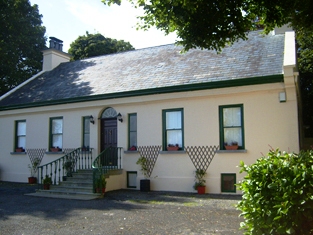
|

